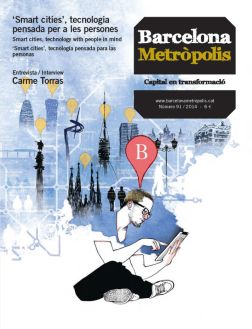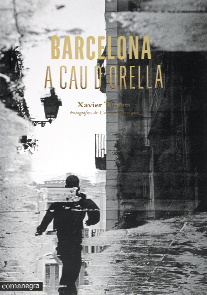[Whispers of Barcelona]
- Xavier Theros (texts), Consuelo Bautista (photographs)
- Ajuntament de Barcelona / Editorial Comanegra
- Barcelona, 2013
- 504 pages
We notice an imbalance, to a certain extent only apparent, as soon we look at the index of Barcelona a cau d’orella, by Xavier Theros: four hundred pages talk about historical Barcelona, the part of the city that, from Plaça Catalunya downwards, includes the Rambla, the Raval, Ciutat Vella, Barceloneta and Montjuïc, and only a hundred deal with the “greater Barcelona” that lies beyond. Theros recognises this on page 406, and gives a reason, which has to do with the origin of the book. It all derives from the Guía secreta de Barcelona (Secret Guide to Barcelona), by Josep Maria Carandell, of which this volume is an update: a complementary operation to that of the reworking of Alexandre Cirici Pellicer’s Barcelona pam a pam, by Itziar González, who this idea came from.
Barcelona a cau d’orella, then, revisits the places from Carandell’s book and tries to recapture their spirit: “It did not say anything about the material heritage of the city, with its monuments and buildings, but another kind of patrimony, ethereal, changing and sometimes chaotic, defined more by movement than by shape.” Often long quotes are cited, as if this book really were a palimpsest of its predecessor, first published in 1974. And yet the chronological distance leads to inevitable differences: forty years ago, Carandell shed light on a Barcelona hidden beneath Francoist discourse to reveal a repressed truth. By contrast, Theros moves through a larger-than-life landscape, a Barcelona turned theme park, with no blood in its veins, a city devoured by its own image. A decadent simulacrum.
But maybe this imbalance has another cause. Except in the historical introductions to each chapter, the text is organised like a walk through precisely evoked streets, passages, squares and buildings; they are the key to a story, an erudite curiosity, the origin of a saying, a vanished world. The Barcelona of Theros (and of Carandell) is not that of urban planning, but that of the locals scraping by; a Barcelona that cannot be seen from a bird’s-eye view, only intuited from the ground. A readable, infinite, unending city. And which, too, is a charming palimpsest. And a city like this is more often than not recognised in what we still call “the centre” than in the different districts, often recent creations.
On the other hand, it is as if this historical Barcelona contained all the others: in his twisted wanderings au flâneur, Theros makes digressions, separate from the main text and dealing with subjects exceeding the limits of each chapter. For this reason we said at the beginning that the imbalance is apparent: from it arise the Heliogàbal bar, Plaça de les Arenes and Plaça Raspall. The text is a maze, sometimes chaotic: there are reiterations, and a spelling and grammar check would have been really good. There is such an exuberance of data that it is missing a street index to orient us within the leafy branches of the text. But Theros moves around with the freedom of a jazz pianist, with an undeniable love of the city. It is a book to be read slowly, with stops.




